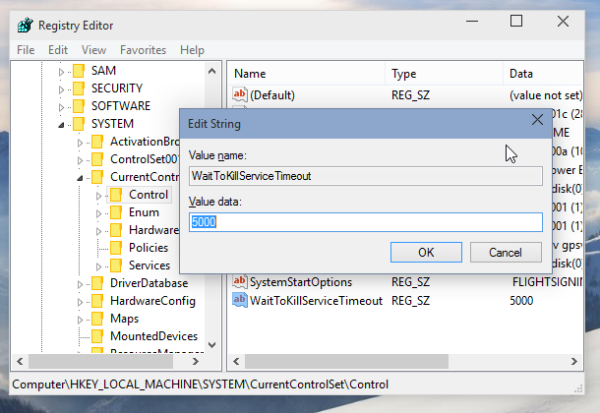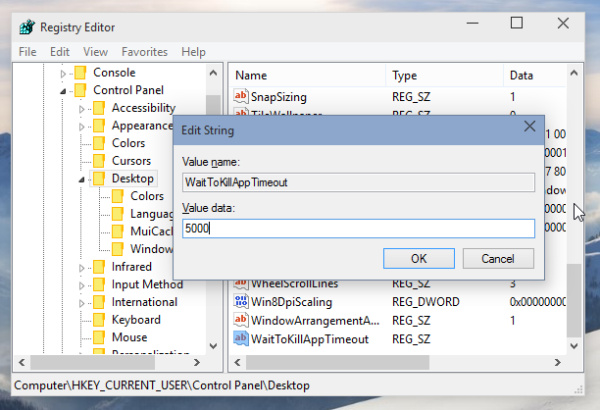If you have experienced slow shutdown in Windows 10, you should know that the OS comes with a built-in ability to speed it up. With a few tweaks, you can significantly speed up the shutdown process. Let's see how it can be done.
Advertisеment
When you shutdown your PC, Windows 10 is waiting for a response from running applications and services. Depending on how your running apps respond to the shutdown call or exit, Windows can take lots of time, especially if some service or app does not finish its job and exit quickly. In the Registry, there are a few settings which define the time in seconds for which the OS will wait before it forcibly kills running applications to proceed with the shutdown. You can reduce this timeout so Windows 10 will perform a faster shutdown and restart much faster.
Here you go.
- Open Registry Editor.
- Go to the following Registry key:
HKEY_LOCAL_MACHINE\SYSTEM\CurrentControlSet\Control
Tip: See how to jump to the desired Registry key with one click.
- See the WaitToKillServiceTimeout REG_SZ value in the right pane:

This is the number in milliseconds for which Windows 10 will wait for every service before it stops that service forcibly. It must be between 1000 and 20000, which corresponds to 1 and 20 seconds respectively. The lower the value, the faster Windows 10 will terminate services. - For interactive applications like Notepad or Word which run in the active user session, another tweak must be applied. Go to the following Registry key located here:
HKEY_CURRENT_USER\Control Panel\Desktop
There you can create 2 REG_SZ values, HungAppTimeout and strong>WaitToKillAppTimeout.
WaitToKillAppTimeout represents the time to wait for a response from a running app. Lowering this value will lead to apps getting killed faster when you restart or shut down Windows.
HungAppTimeout specifies the time Windows allows for the app to exit before the app is considered as having hanged or unresponsive. A low value means the app will be considered as unresponsive very quickly and Windows will ask you to terminate it. - Restart Windows 10 for the changes to take effect.
Common suggestions
- I do not recommend you to tweak HungAppTimeout and WaitToKillAppTimeout parameters. If you set these values too low, it can lead to issues such as app being unable to save their data properly, as Windows kills them before they can do that.
- Do not set WaitToKillServiceTimeout to 1 second or even to 12 seconds. Remember, some services need time to save their data and settings. Instead, experiment with WaitToKillServiceTimeout value and try to find the optimal period which affects the shutdown process without losing any data or causing corruption.
That's it.
Support us
Winaero greatly relies on your support. You can help the site keep bringing you interesting and useful content and software by using these options:

Good one Sergey though I wouldn’t be meddling with the above as I believe they are set for a reason. :)
You believe? but do you have a mind of your own to….think ? A little bit of balls people, stop being sheep’s and take the jump! …
what the author wrote is 101% true – why do read things you don’t understand or don’t even care to understand – not to mention this is ooolllld easy stuff.
I found this sentence: “There you can create 2 REG_SZ values, HungAppTimeout and strong>WaitToKillAppTimeout”. What does “strong>WaitToKillAppTimeout” mean?
The two REG_SZ values would be string values, “HungAppTimeout” and the other “WaitToKillAppTimeout”.
1. In the registry Editor , trace the path .
2. With “Control highlighted, right-click on the right hand panel (REG_SZ side). Then click “new” and “string value” in the options list.
3. The two entries, “HungAppTimeout” and the other “WaitToKillAppTimeout”, suggested by Sergey Tkachenko, can then be added to the “New Value #*” boxes.
4. Right click the newly Named entries to modify/enter the values that you require.
5. As Sergey suggested, add or change entries with caution.
6. I added this note, with appreciation to Sergey, because I am a novice and was also a little uncertain. However, the process description, he offered, worked for me. Thank you, Sergey.
I’m interested to know how to Speed up Shutdown in Windows 10. So i have been browsing in many websites, but I feel yours is good.
Thanks for kind words.
We get irritated while the shutdown of the system takes more time. To avoid this drawback, this article is very useful.
Thanks,
I got the opposite problem. The computer ends too quick, so the software – GoodSync, does not get the time to syncronize my hard drive with the network drives. I adjusted the parameters in the register and it works excelent.
I have suffering for a long time from such problem,but with this solution the problem was fixed …. thank you